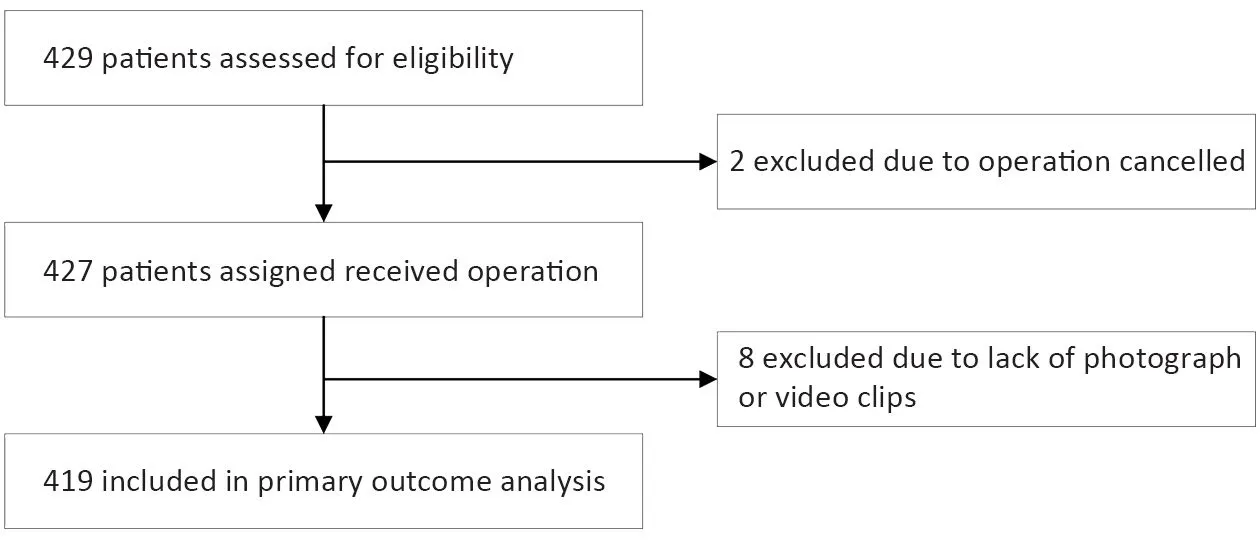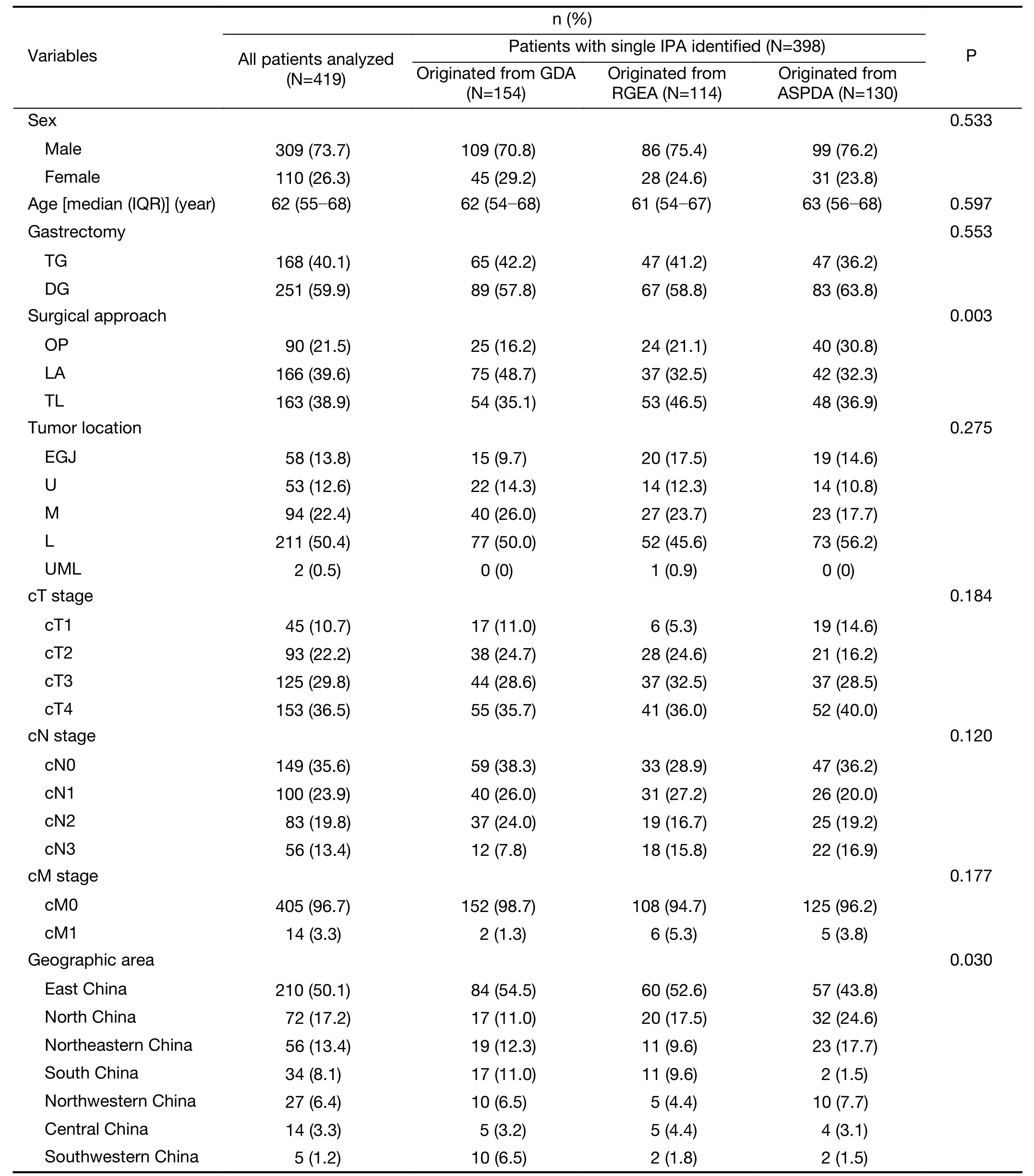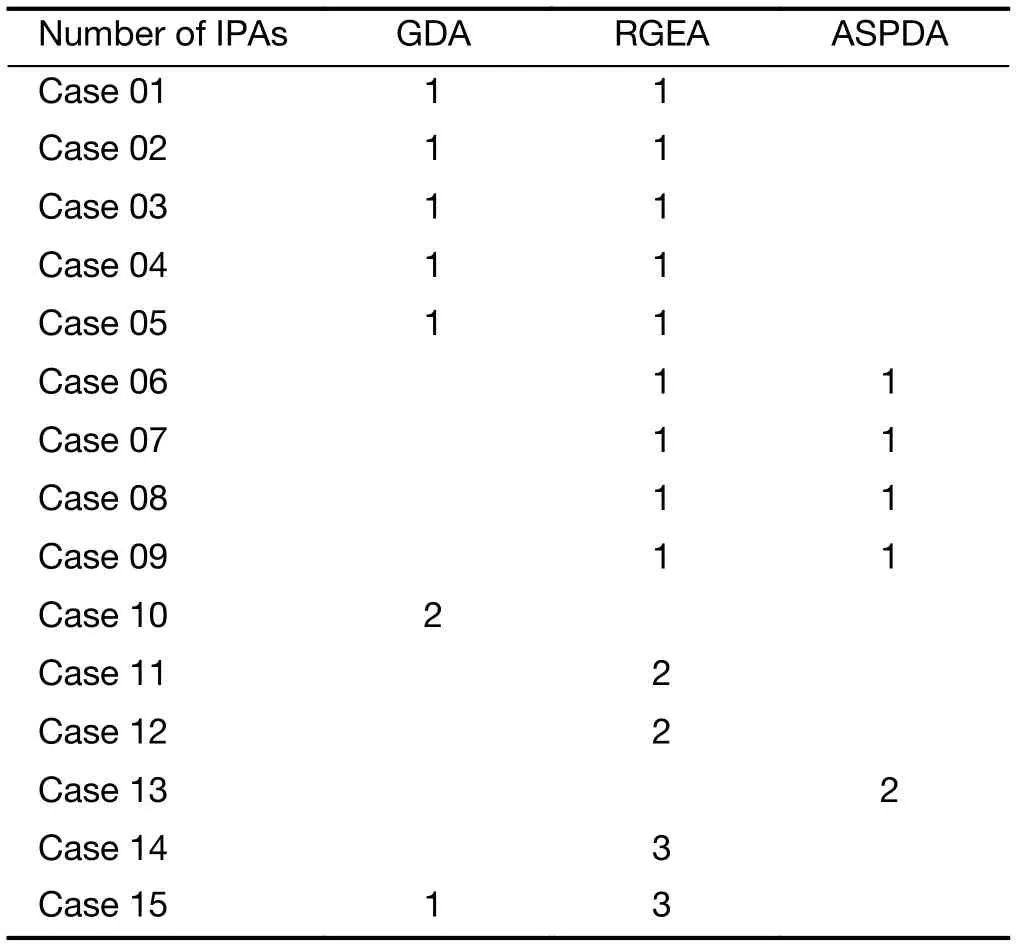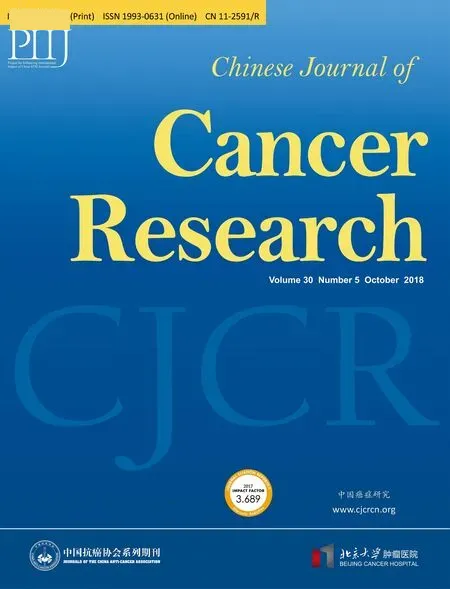Anatomical variation of infra-pyloric artery origination: A prospective multicenter observational study (IPA-Origin)
Rulin Miao, Jianjun Qu, Zhengrong Li, Daguang Wang, Jiang Yu, Weidong Zang, Yong Li,Fenglin Liu, Jian Zhang, Wu Song, Kai Ye, Su Yan, Wei Wang, Shuangyi Ren, Lu Zang,Changqing Jing, Li Zhang, Kuan Wang, Weihua Fu, Lin Fan, Bin Liang, Gang Zhao,Jun Cai, Li Yang, Jiaming Zhu, Jun You, Kun Yang, Qingxing Huang, Zhaojian Niu,Ning Ning, Xingfeng Qiu, Gang Ji, Feng Liang, Hua Huang, Chao Gao, Fei Shan,Shuangxi Li, Yongning Jia, Lianhai Zhang, Xiangji Ying, Yan Zhang, Zhaode Bu, Xiangqian Su,Gang Zhao, Ziyu Li, Jiafu Ji
1Key Laboratory of Carcinogenesis and Translational Research (Ministry of Education/Beijing), Gastrointestinal Cancer Center, Peking University Cancer Hospital & Institute, Beijing 100142, China; 2Department of Surgical Oncology, Weifang People’s Hospital, Weifang 261000, China;3Department of General Surgery, the First Affiliated Hospital of Nanchang University, Nanchang 330006, China; 4Department of Gastrointestinal Surgery, the First Hospital of Jilin University, Changchun 130021, China; 5Department of General Surgery, Nanfang Hospital, Southern Medical University, Guangzhou 510515, China; 6Department of Gastrointestinal Cancer Surgery, Fujian Provincial Cancer Hospital, Fuzhou 350014,China; 7Department of General Surgery, Guangdong General Hospital, Guangdong Academy of Medical Sciences, Guangzhou 510080, China;8Department of General Surgery, Zhongshan Hospital, Fudan University, Shanghai 200032, China; 9Department of Gastrointestinal Surgery,Hangzhou First People’s Hospital, Hangzhou 310006, China; 10Department of Gastrointestinal Surgery, the First Affiliated Hospital, Sun Yat-sen University, Guangzhou 510080, China; 11Department of Surgical Oncology, the Second Affiliated Hospital of Fujian Medical University, Quanzhou 362000, China; 12Department of Surgical Oncology, Affiliated Hospital of Qinghai University, Xining 810001, China; 13Department of Gastrointestinal Surgery, Guangdong Provincial Hospital of Chinese Medicine, Guangzhou 510120, China; 14Department of General Surgery, the Second Hospital of Dalian Medical University, Dalian 116023, China; 15Department of General Surgery, Shanghai Ruijin Hospital, Shanghai Jiaotong University School of Medicine, Shanghai 200025, China; 16Department of Gastrointestinal Surgery, Shandong Provincial Hospital Affiliated to Shandong University, Jinan 250021, China; 17Department of Gastrointestinal Surgery, Harbin Medical University Cancer Hospital,Harbin 150081, China; 18Department of General Surgery, Tianjin Medical University General Hospital, Tianjin 300052, China; 19Department of General Surgery, the First Affiliated Hospital of Xi’an Jiaotong University, Xi’an 710061, China; 20Department of Gastroenterological Surgery,Peking University People’s Hospital, Beijing 100044, China; 21Department of General Surgery, National Center of Gerontology, Beijing 100730,China; 22Department of General Surgery, Beijing Friendship Hospital, Capital Medical University, Beijing 100050, China; 23Department of Gastrointestinal Surgery, Jiangsu Province Hospital, the First Affiliated Hospital of Nanjing Medical University, Nanjing 210005, China;24Department of Gastrointestinal Surgery, the Second Hospital of Jilin University, Changchun 130041, China; 25Department of Gastrointestinal Surgery, the First Affiliated Hospital of Xiamen University, Xiamen 361003, China; 26Department of Gastrointestinal Surgery, West China Hospital of Sichuan University, Chengdu 610041, China; 27Department of Digestive Endoscopic and Minimally Invasive Surgery, Shanxi Provincial Cancer Hospital, Taiyuan 030013, China; 28Department of General Surgery, the Affiliated Hospital of Qingdao University, Qingdao 266003, China;29Department of Gastrointestinal Surgery, Peking University International Hospital, Beijing 102206, China; 30Department of Gastrointestinal Surgery, Zhongshan Hospital Xiamen University, Xiamen 361004, China; 31Department of Gastrointestinal Surgery, Xijing Hospital, Fourth Military Medical University, Xi’an 710032, China; 32Department of General Surgery, the 307th Hospital of Chinese People’s Liberation Army,Beijing 100071, China; 33Department of Gastric Surgery, Fudan University Shanghai Cancer Center, Shanghai 200032, China; 34Department of Gastrointestinal Surgery, Renji Hospital, School of Medicine, Shanghai Jiaotong University, Shanghai 200127, China
Abstract Objective: Infra-pyloric artery (IPA) is an important anatomical landmark in treatment of gastric cancer and is the key vessel for pylorus-preserving gastrectomy and subgroup of infra-pyloric lymph nodes. However, its anatomical variation is not thoroughly understood. Our study aimed to clarify the origination of the IPA.Methods: We did this prospective, multicenter, open-label, observational study at gastric surgery departments of 34 hospitals in China. Gastric cancer patients aged 18 years or older and scheduled to undergo elective total or distal gastrectomy were assigned. During the surgery, IPA dissecting and exposing the origination point with photographs or video clips were required. The primary outcome was the origination of the IPA. Analysis of variance, χ2 tests and Fisher’s tests were used to analyze the differences between groups. The study is registered at Clinicaltrials.gov (No. NCT03071237).Results: Between May 8 and July 31, 2017, 429 patients were assigned for the study, and 419 (97.7%) patients had the IPA dissected and recorded through photograph or video and were included in the primary outcome analysis. The median age was 62 years old, and 73.7% were male. Among the patients, 78.5% received laparoscopic surgery. Single IPA origination was identified in 398 (95.0%) patients, including gastroduodenal artery (GDA) in 154 (36.8%) patients, anterior superior pancreaticoduodenal artery (ASPDA) in 130 (31.0%) patients, and right gastroepiploic artery (RGEA) in 114 (27.2%) patients. Fifteen (3.6%) patients were identified with multiple IPA and 6 (1.4%) patients were identified as IPA absence. The differences in the distribution of surgical approach(P=0.003) and geographic area (P=0.030) were statistically significant. No difference was shown in sex, age,gastrectomy type, tumor location, and clinical T, N and M stage.Conclusions: Our study found that the IPA originates from GDA, ASPDA and RGEA in similar proportions.Laparoscopic surgery may be more helpful in dissection of the IPA than open surgery.
Keywords: Infra-pyloric artery; origination; anatomy; gastric cancer
Introduction
Gastric cancer is one of the most common malignant tumors worldwide and infra-pyloric artery (IPA) is an important anatomical landmark for its treatment (1,2). The IPA is the predominant artery to the pyloric antrum (3).For early gastric cancer, the IPA must be preserved in the pylorus-preserving gastrectomy (PPG) to maintain the blood supply and normal function of pylorus (2,4-6). In the 15th Japanese gastric cancer classification guideline, the infra-pyloric (No. 6) lymph node (LN) can be divided into 3 sections: the 6a, 6v, and 6i LN sections; and the 6i section is defined as LNs along with IPA (7,8). Thus, a thorough understanding of the anatomical variation of the IPA is very important (9).
The importance of the IPA was brought to attention just in recent years, and most studies were based on angiography and autopsy with limited sample size. Due to the small size of the vessel, the anatomy of the IPA is still poorly understood. Sawaiet al. evaluated the pyloric vascular anatomy of 210 celiac angiograms and showed that the IPA originated from gastroduodenal artery (GDA) in 63.8% of all patients and originated from other arteries in the other 36.2% of patients (23.8% from pancreaticoduodenal arcade and 12.4% from right gastroepiploic artery) (4). In a study based on 20 autopsies by Shenet al.,the IPA likewise mainly originated from GDA (51.6%) and right gastroepiploic artery (RGEA, 29.0%) (10). However,in a more recent study by Harutaet al. based on 156 surgical dissection and specimens, most of the IPAs originated from the anterior superior pancreaticoduodenal artery (ASPDA, 64.2%) or the root of the RGEA (23.1%),and only a small portion originated from the GDA (12.7%)(11). Thus, the anatomical variation of the IPA origination remains controversial and the data sample of existed evidence is too limited to clarify the variation. We did this“IPA-Origin” study to clarify the anatomical variation of the IPA origination.
Materials and methods
Study design
We did this prospective, multicenter, open-label,observational study at gastric surgery departments in 34 hospitals in China. Gastric cancer patients aged 18 years or older and scheduled to undergo elective total or distal gastrectomy were asked to participate in the study before surgery and to sign the informed consent form. We excluded patients whose No. 6 LNs were clinically enlarged and the IPA dissection was inappropriate for cancer surgery, and those who received surgery but without the IPA dissected, photographed, or video-recorded.
The study protocol was approved by the Institutional Review Board of Medical Ethics Committee of Peking University Cancer Hospital, and by the review boards of each study center before the initiation of patient enrollment. All participants gave written informed consent.A data monitoring board was constituted before the start of the study for data collection, quality control and progress monitoring. The board consisted of two surgeons and one statistician. In order to minimize the selection and reporting bias that surgeons may avoid to report unfavorable cases after surgery, the basic information and surgical plan of the patients were required to be reported to the board at least one day before surgery. The progress of the study was reported to all investigators every week by the data monitoring board.
Procedure and clinicopathologic evaluation
Dissecting of the IPA and exposing the origination point were required during the surgery. The intraoperative photographs or surgical video clips that could show the origination of the IPA must be taken or recorded. For patients whose IPA was identified as absence, a surgical video clip was required for review. After the surgery, the photographs or the surgical video clips with the IPA origination marked by the investigators would be sent to the data monitoring board. For the cases that the IPA origination could not be identified clearly, the photographs or the video clips would be sent to all investigators and be discussed through an instant-messaging software to clarify the origination.
The gastrectomy type was defined as total gastrectomy or distal gastrectomy. The operation approach was recorded as open surgery, laparoscopic-assisted surgery or totally laparoscopic surgery. The clinical TNM stage of the tumor was evaluated clinically according to the 7th American Joint Committee on Cancer (AJCC)/Union for International Cancer Control (UICC) gastric cancer staging system (12). The location of tumor was defined according to the Japanese classification of gastric carcinoma as esophagogastric junction, upper third, middle third, and lower third of the stomach (13). The geographic area was defined as the area that the patient was born and was divided into 7 regions according to the Chinese geographical division as follows: East China, North China,South China, Central China, Northwestern China,Northeastern China, and Southeastern China.
Outcomes
The primary outcome of the study was the origination of the IPA, defined as the upstream artery where the root of the IPA was located. If there was only one IPA identified,the origination of the IPA would be recorded as the GDA,the RGEA, the ASPDA, or the other artery else. If multiple IPAs were identified, originations of each IPA would be recorded. If the IPA was not identified, the origination would be defined as absence.
Statistical analysis
We postulated that the IPA mainly originated from the GDA. On the basis of the results of the study by Sawaiet al., we calculated that 372 patients would be needed to produce a two-sided 95% confidence interval (95% CI)with a width equal to 10% when the sample proportion is 64%. We aimed for a total of 409 patients to correct for an estimated 10% loss to follow-up.
We analyzed differences between groups of the IPA origination with analysis of variance (ANOVA) for continuous variables, χ2tests and Fisher’s tests for categorical variables. Normal distribution of data was tested and confirmed by Kolmogorov-Smirnov test. A two-sided P-value of less than 0.05 was regarded as statistically significant. All values are expressed in the following manner unless otherwise stated: n (%) or median (interquartile range, IQR). We did statistical analysis with IBM SPSS Statistics (Version 20.0; IBM Corp., New York, USA).This study is registered at Clinicaltrials.gov (No.NCT03071237).
Results
Patient characteristics

Figure 1 Study profile.
Figure 1shows the study profile. Between May 8 and July 31, 2017, we considered and assessed the eligibility of 429 patients for the study. Four hundred and nineteen (97.7%)patients had the IPA dissected and recorded through photograph or video during gastrectomy and were included in the primary outcome analysis (Figure 1). The location of centers and numbers of patients enrolled in each center are shown inSupplementary Table S1.
Baseline characteristics are shown inTable 1. The median age of all patients was 62 (IQR, 55-68) years old and 73.7% of the patients were male. Most patients received laparoscopic surgery (78.5%) and distal gastrectomy (59.9%). Most of the tumors were located in the middle or lower third of the stomach (72.8%) and locally advanced gastric cancer was the main part (85.9%).Most patients (80.7%) were from East China, North China and Northeastern China.
IPA origination and its relationship with clinicopathological characteristics
Of 419 patients analyzed, single IPA origination was identified in 398 patients (95.0%, 95% CI: 92.9%-97.1%),including GDA in 154 patients (36.8%, 95% CI:32.2%-41.4%), ASPDA in 130 patients (31.0%, 95% CI:26.6%-35.4%), and RGEA in 114 patients (27.2%, 95%CI: 22.9%-31.4%). Fifteen patients (3.6%, 95% CI:1.8%-5.4%) were identified with multiple IPA origination(Table 2) and 6 patients (1.4%, 95% CI: 0.3%-2.5%) were identified as IPA absence. There was no statistically significant difference in clinicopathological factors among patients with single origination, multiple originations and IPA absence (Supplementary Table S2).
Of 398 patients with single IPA identified, the clinicopathological factors were compared among patients with different originations (Table 1). The differences in the distribution of surgical approach (P=0.003) and geographic area (P=0.030) were statistically significant. No difference was shown in sex, age, gastrectomy type, tumor location,and clinical T, N and M stage.
Among the 15 patients with multiple IPAs, there were 13 patients with 2 IPAs, 1 patient with 3 IPAs and 1 patient with 4 IPAs (Table 2). Thirteen of the 15 patients had at least one IPA originated from the RGEA.
Patients without IPA identified were compared with those with IPA identified, and no statistically significant difference was observed.
Discussion
Our findings show that the IPA originates from GDA(36.8%), ASPDA (31.0%) and RGEA (27.2%) in similar proportions. A small proportion of patients are with multiple IPAs or with IPA unable to be identified.
The IPA is a small artery first described by Rossiet al. in 1904 and is the main blood supply for the pylorus (3,14,15).For early gastric cancer that is suitable for PPG, the IPA must be preserved to maintain the blood supply of pylorus and the dissection of the IPA is the key technique for the surgery (2,4,5). For patients whose IPA is absent or cannot be clearly identified and preserved, PPG cannot be performed. According to the 15th Japanese classification of gastric cancer, the No. 6 LNs can be divided into 3 subgroups: the 6a, 6v, and 6i LNs based on the study of Shinoharaet al. (7). Among these subgroups, the 6i LNs lie along with the IPA. However, whether the lymphatic drainage of 6i LNs would be affected by the anatomical variation is still not clear.
Studies evaluating the origin of the IPA are few and the results are obviously different. Sawaiet al. reported that the proportions of the IPA originated from the GDA, RGEA,and ASPDA were 63.8%, 12.4%, and 21.4% based on 210celiac angiograms (4). And there were 2.4% of IPAs originated from posterior superior pancreaticoduodenal arcade and no IPA absence was observed. According to the study by Shenet al. based on 20 autopsies, the IPAs were identified in all cases and 51.6% of the IPA originated from the GDA, 29.0% from the RGEA, and 19.4% from the ASPDA (10). In Shen’s study, two IPAs were observed in 55% of all cases and all the IPAs that originated from ASPDA were located closely to the root of the ASPDAs. In a more recent study by Harutaet al. based on 156 laparoscopic intraoperative dissection and postoperative specimen processing, in 73.7% of the patients, the IPA was located intraoperatively, and in the remaining 26.3% of the patients, the IPA was detected postoperatively in specimens(11). In Haruta’s study, 64.2% of the IPA originated from the ASPDA, 23.1% from the RGEA, and 12.7% from the GDA, which is obviously different from studies of Sawai and Shen. In our study, the IPA is located intraoperatively in 98.6% of the patients, and 36.8% singly originated from the GDA, 31.0% from the ASPDA, and 27.2% from the RGEA. There are 3.6% of the patients identified with multiple IPAs and 86.7% of the patients have at least one IPA originating from the RGEA.

Table 1 Baseline characteristics of all patients analyzed and patients with single IPA identified

Table 2 Cases of multiple IPAs identified
There are several possible reasons for the variety in the proportions of the IPA origination reported in different studies. The first possible explanation is genetic factors which may be reflected by the geographic area of the patients. By far, the proportions reported by studies in Japan and China appear to be different. In our study, the distribution of the IPA origination shows statistically significant difference in different geographical regions.
Additionally, the potential reason for this inconsistency may be the difference in the methods used to identify the IPA. Sawai’ study and Shen’s study identified the IPA with angiogram or autopsy, which can detect the IPA of small size or with rare origination such as poster superior pancreaticoduodenenal arcade. Haruta’s study and our study identified the IPA mainly by intraoperative IPA dissection. If the IPA is too small or originate insidiously, it may not be identified intraoperatively. This part of patients should be paid with more attention if PPG is planned.Furthermore, surgical approach may be associated with capacity of effective detection of the IPA intraoperatively.We found the distribution of IPA origination differed by the surgical approaches performed. Particularly, the proportion that the IPA originated from the GDA was lower in open surgery compared to laparoscopic surgery.One potential explanation for this phenomenon is as following. The Haruta’s study showed that the length of the IPA from pyloric ring to proximal branch is the shortest if the IPA originated from the GDA (9.0 mm from the GDAvs. 21.8 mm from the ASPDAvs. 20.6 mm from the RGEA, P<0.01). In laparoscopic surgery, as opposed to open surgery, the surgical field is digitally enlarged and the identification of short vessels can be more accurate. The shorter length of the IPA may lead to a higher risk of intraoperatively unconscious dividing of the vessel. From this point, the PPG is more suitable to be performed by laparoscopic surgery than by open surgery.
Another reason that may affect the identification of the IPA is the learning curve of the surgeons who dissected the IPA during the surgery. The dissection of small vessels such as the IPA is an advanced technique and requires more adept skills than that of large vessels. For surgeons with limited experience, small IPA may be undetected intraoperatively and reported as an absence. In our study,the top two centers regarding the enrollment numbers recruited 26.5% of all analyzed patients. Among patients in these two centers, the IPA mainly originated from the ASPDA, followed by the RGEA and the GDA (41.4%,38.7%, 15.3%, respectively, P<0.001). These proportions are closer to the result of Haruta’s study which was likewise conducted in a large hospital.
The main limitation of our study is that the patients participated is not a consecutive cohort and selection or reporting bias may exist. In order to minimize the bias, the enrollment of the patients was arranged before surgery and patients whose surgery were cancelled or had no photographs or videos recorded are excluded from the analysis. This helps to control the bias. Secondly, some surgeons in our study are lack of experience of the IPA dissection, which may result in the inaccuracy of the IPA dissection. From this point, the result of our study may not be able to fully prove the IPA distribution difference by regions due to the imbalance of patient distribution and surgeon experience by geographical regions. However, this is a better reflection of the real clinical practice setting, as compared with angiograms and autopsies. Another limitation is that most patients (80.7%) were from East China, North China and Northeastern China, and this distribution imbalance reflects that the study sample may be not representative enough of Chinese gastric cancer patients.
Conclusions
Our study found that the IPA originates from GDA(36.8%), ASPDA (31.0%), and RGEA (27.2%) in similar proportions. Laparoscopic surgery may be more helpful in dissection of the IPA than open surgery. To our best knowledge, this study is by far the largest study to describe the anatomical variation of the IPA and therefore can provide helpful information for studies on PPG and subgroups of the No. 6 LNs. However, the current study did not explore the association between the different origination of the IPA and its influence on PPG or lymphatic drainage of the No. 6 LNs, which needs to be further examined in the future studies.
Acknowledgements
The study is funded by the GastricCancer Diagnose and Treatment Project (D171100006517004, D171107006 50000) of Beijing Municipal Science & Technology Commission and supported by Beijing Municipal Administration of Hospital Clinical Medicine Development of Special Funding Support (ZYLX201701).
Footnote
Conflicts of Interest: The autho rs have no conflicts of interest to declare.
 Chinese Journal of Cancer Research2018年5期
Chinese Journal of Cancer Research2018年5期
- Chinese Journal of Cancer Research的其它文章
- Clinical study of ultrasound and microbubbles for enhancing chemotherapeutic sensitivity of malignant tumors in digestive system
- Probe-based confocal endomicroscopy is accurate fordifferentiating gastric lesions in patients in a Western center
- A comparative study of totally laparoscopic distal gastrectomy versus laparoscopic-assisted distal gastrectomy in gastric cancer patients: Short-term operative outcomes at a high-volume center
- Immunohistochemical expression of thymidylate synthase and prognosis in gastric cancer patients submitted to fluoropyrimidine-based chemotherapy
- Oxaliplatin plus S-1 or capecitabine as neoadjuvant or adjuvant chemotherapy for locally advanced gastric cancer with D2 lymphadenectomy: 5-year follow-up results of a phase II-III randomized trial
- Feasibility of personalized treatment concepts in gastrointestinal malignancies: Sub-group results of prospective clinical phase II trial EXACT
